On the Hunt for stock wheel upgrades.
Apologies for the dad joke…. Usually the guide of ‘cheap/fast/good – pick two’ holds true. In the context of that saying, fast means speed of delivery, but in our mountain-biking world we take it to mean fast rolling. No-one seems to have told Hunt Wheels that their budget-minded offerings should make any sacrifice in order to hit price-points though. There’s no denying Hunt’s pricing structure is at the lower end of the range for aftermarket mountain bike wheelsets, but this is not a bad thing when the trade-offs with quality and performance are minimal – perhaps even non-existent.
This review is a little different in that we’re covering two styles of wheelsets – not in a direct head-to-head conflict style, but with the view that both products provide a budget-conscious offering for riders upgrading their stock wheels. The wheelsets in question are the alloy Hunt XC Wide, and the Hunt All Mountain Carbon. Although the XC wheelset is legitimately an option for riders who are all about the climbs (lightweight and relatively narrow by current standards) they’re an equally valid consideration for all-round trail riders who simply want to ride up, down, around and over all sorts of terrain, without a focus on pure climbing performance.
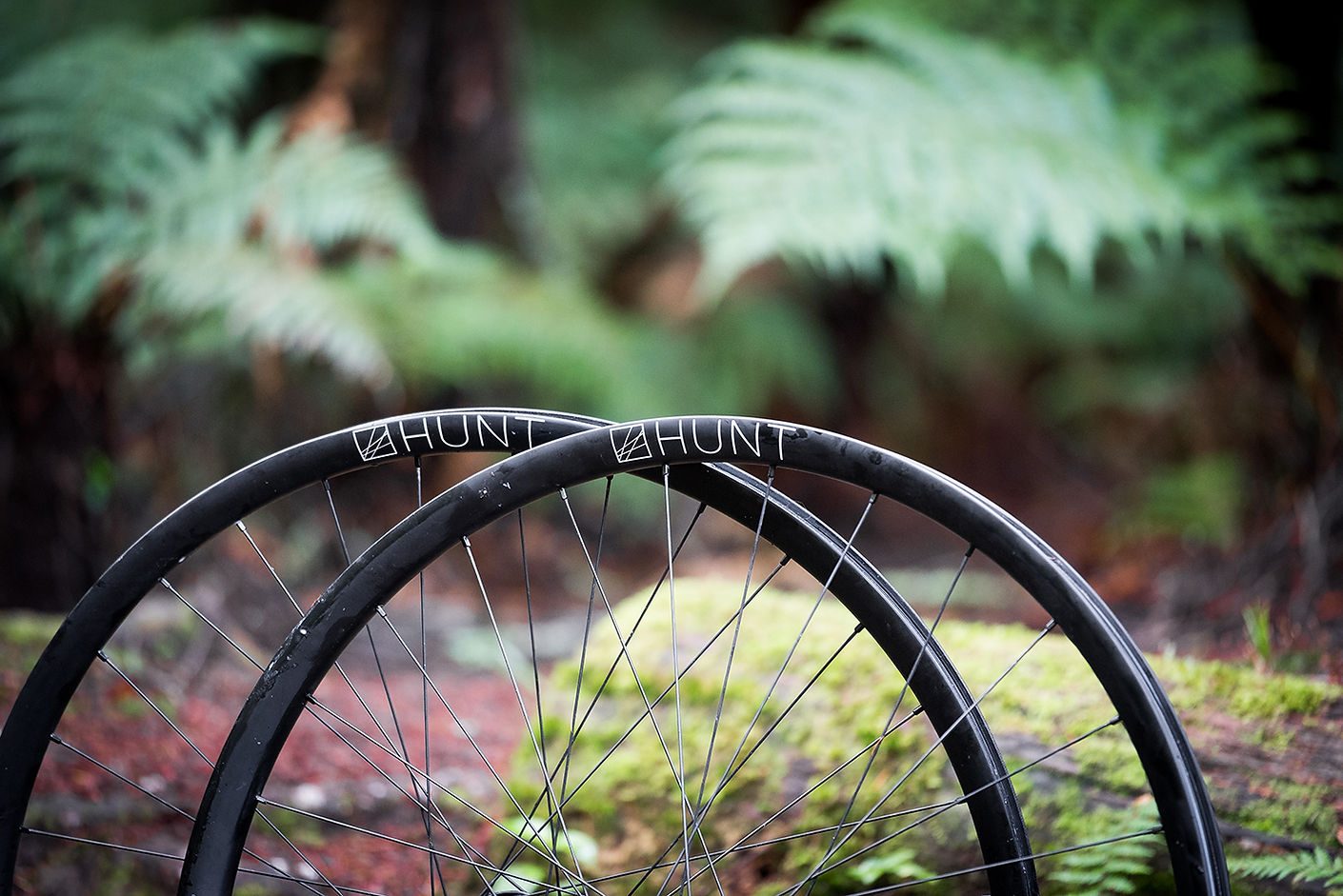
At face value, one wheelset is XC labeled – alloy and lightweight – while the other is trail oriented – carbon with a performance carbon design. What makes these worth speaking about together, really comes down to pricing. For a rider looking to upgrade their stock OEM wheelset of no-name, or house-brand rims and hubs, both these options are feasible considerations. Keep in mind, the XC Wide is only available in 29, while the carbon All Mountain is offered in both 29 and 27.5 guises.
Alloy – modest, but capable of embarrassing much fancier, more expensive offerings. First up, the alloy XC Race Wide wheelset. At $700 including shipping, these are available at a sharp price, largely due to Hunt’s online, direct-to-consumer model, which is increasingly common these days. When ordering online, you choose a SRAM XC, Shimano or Microspline driver. Your wheels arrive with tubeless rim tape and valves installed, along with the driver you specified. You’ll also get four spare spokes, of the correct length, for each wheel/side and a spoke key with inset tool specific to the wheelset. You’ll also receive a couple of stickers for your toolbox, your kid’s lunchbox or the neighbour’s letterbox.
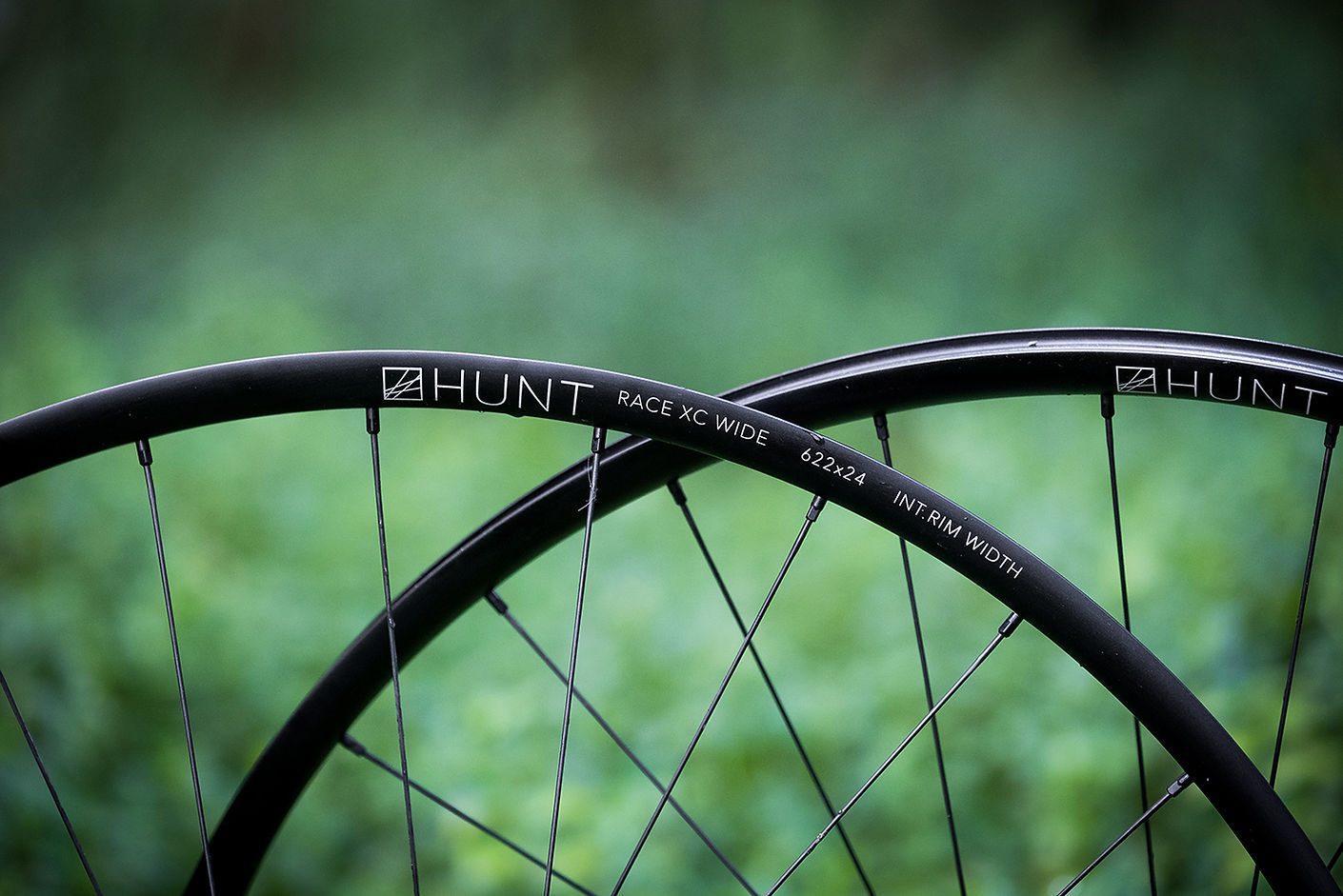
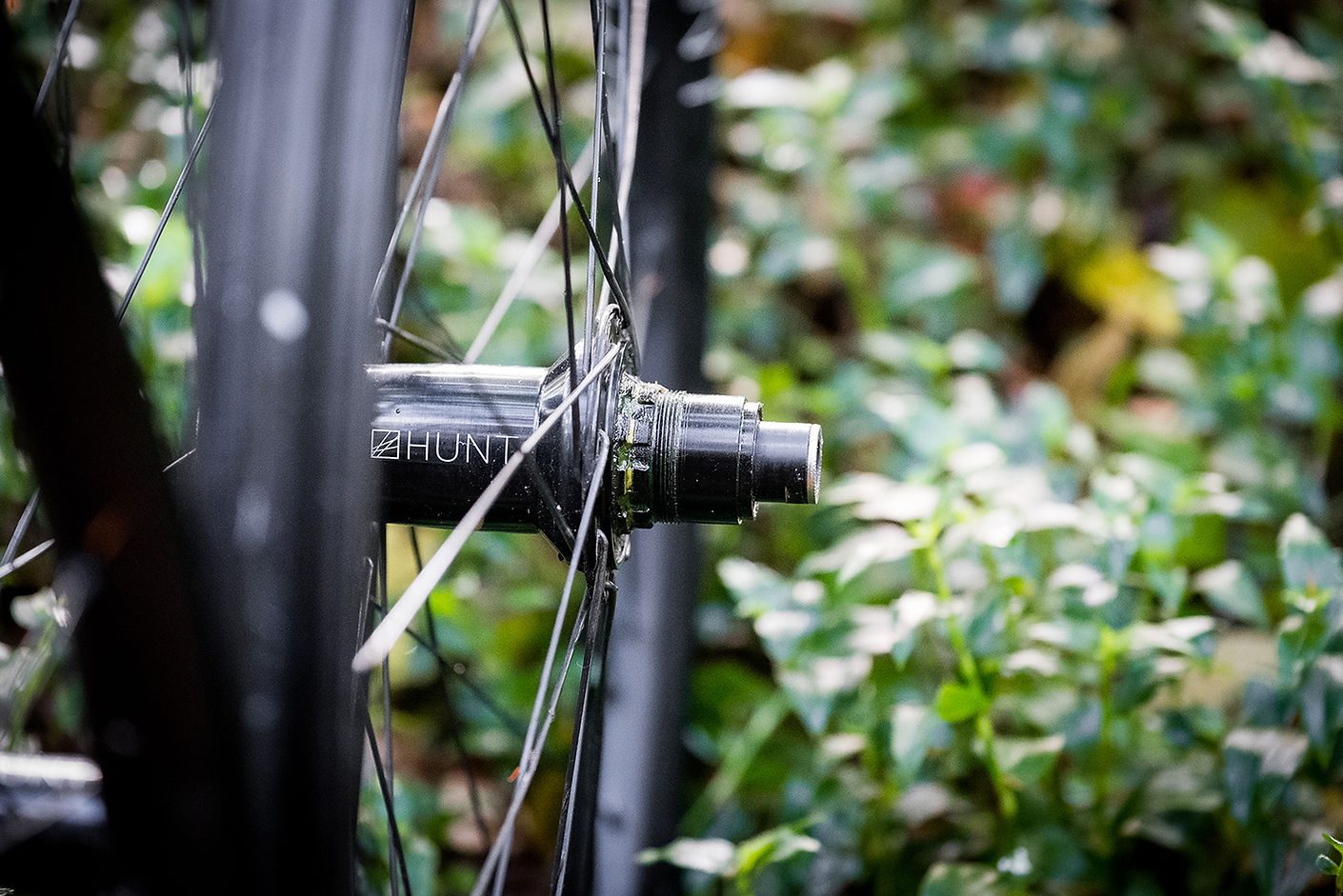
The XC Race Wides utilise 28h front and rear with straight pull spokes. Those spokes benefit by being weight saving, but the downside is that they’re a little tougher to true. Alloy nipples offer a weight saving over brass, but are not my personal favourite as they can eventually round off with repeated truing. These are hard-anodised though, so long-term truing shouldn’t involve too much swearing… hopefully. Their weight, with rim tape and driver mounted (but no valve or discs), is 820g for the rear and 780g for the front – giving a flat 1500g total for the 29er wheelset. That is only 17g off their claimed weight and remarkably lighter than competitors in the same price bracket. If the rider’s goal was to achieve a lighter wheelset than that, it would invariably mean going carbon, at quadruple the price – or more. These are on par with the lightest alloy wheelsets available. In-the-field testing show the wheels hold up reliably on a go-everywhere trail bike, but there are limitations to the nature of narrow, stiff alloy rims.
It is worth noting that the XC Wides use 6069-T6 heat-treated alloy, rather than 6061-T6 some competitors use. 6069 essentially claims to offer significantly greater tensile strength at 60+%. This results in Hunt using less material – and therefore less weight for comparable strength. With regard to rim width, a 2.3 trail tyre, inflated to the same pressure, is 68mm wide on the XC Wide’s 24mm I.D. rim, compared to the same tyres’ 70mm inflated width on a 28mm I.D. rim. There is a difference and it is noticeable, but it’s not night and day. Hunt recommend 2.1 to 2.35 tyres. I ran 2.0s and 2.4s because I like to push the boundaries of what I’m told to do. Somewhat predictably, I ended up running 2.3s which felt the most natural, given the rim’s width. Strike one for the rebel spirit. The mounting of all tubeless was painless, with a modest home garage floor-pump set up.
Hunt’s six pawl rear hub, with 72 engagement points, sounds appropriately refined when freewheeling.
In practice, the alloy XC Wides are fantastic – and average, and sub-par! Any review of a product is influenced by the point of reference – what the product is being compared with and measured against, as well as the rider’s intent on how it should be used. If pitching the XC Wides against competitors of far higher cost, of course they’re not quite going to measure up in performance. Likewise, measuring them against any quality carbon wheelset – as we’re about to do here with their trail carbon brethren – is an unbalanced comparison. But, compare them to stock wheels – that come equipped on otherwise capable trail bikes – and we’re talking real improvements, both in terms of weight, long-lasting quality and riding performance. It’s for this reason we’re showcasing the XC Wides as a valid trail bike option, not just a niche XC-racing only product.
It’s not all roses though. The nature of narrow-ish alloy wheels is relatively abrupt tyre profiles (comparing the same sized tyres on wider rims) leading to sudden release of traction when cornering aggressively, and harsher lateral ‘feel’ on choppy terrain. Those couple of millimetres that the Vernier calipers show in inflated tyre width, are negligible on paper but noticeable in use. The feel is difficult, if not impossible, to quantify – apart from relying on anecdotal feedback about how it feels compared to other wheelset options, on sections of trail I know like the back of my hand. They’re just a bit harsh, pinging off deflections of trail surface. It’s an incredibly fine line, but an observable one if you’ve experienced other options. This serves to segue into our feedback on the Hunt Carbon All Mountain wheelset.
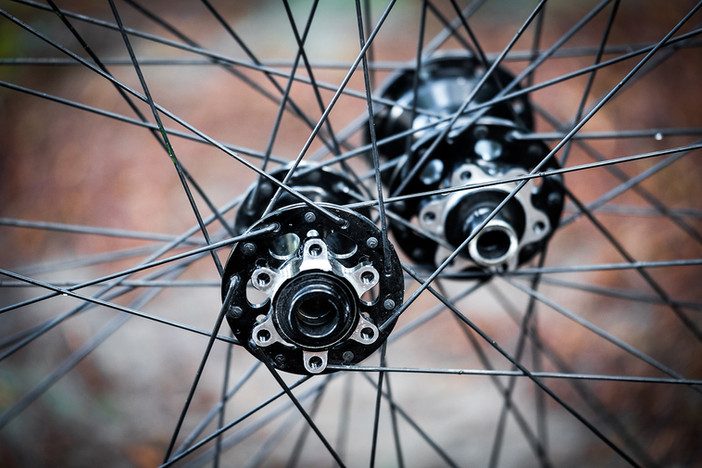
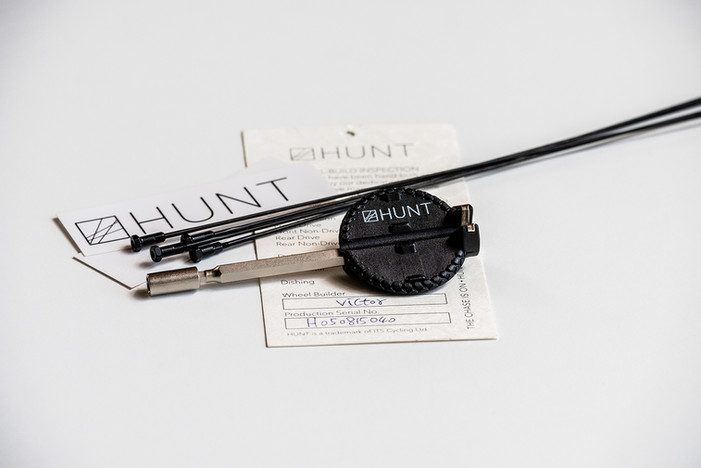
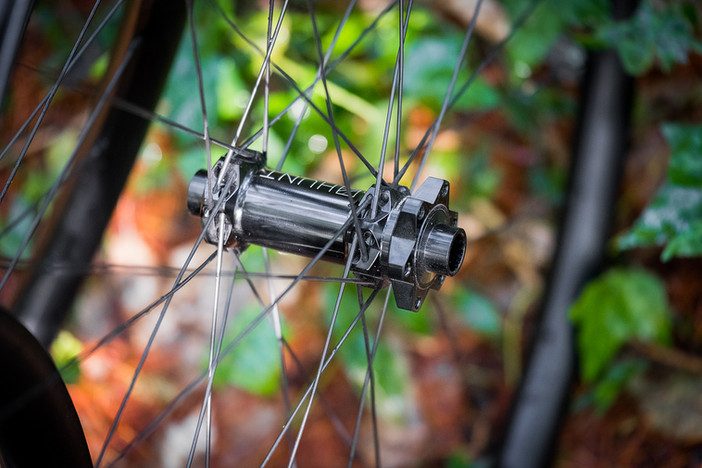

Carbon – done right. This is maximum performance without extravagant brand packaging. The price of these is double that of Hunt’s alloy XC Wides. The performance, however, is not double, but is considerable. It’s a prime example of the benefit of diminishing returns. Improvements are evident, but not by the multiples of dollar value. For those who don’t demand the most performance – and its corresponding price-tag – or who value light weight with an emphasis on the benefits it offers, the XC Wides should be high on their list of considerations.
Back to the Carbons… for those with higher expectations of their wheels, and the budget to suit, the All Mountain Carbons have a lot to offer. Overall, the Hunt Carbons have the following characteristics (they’re pitched as ‘features’, but some of them are only features if they are important to you). POE (Points of Engagement) of the freewheel are a case in point. On one hand, the three-degree POE means you have minimal delay in the feeling of getting on the gas. Also, they make a high-tech buzzy sound without being ridiculously loud, like the swarm-of-wasps some of their premium brand competitors seem to be aiming for with their acoustics. It’s nice to have the instant-on kind of pickup, but not really a game changer for a general trail rider. If you’re riding very technical pedalling sections that benefit from trail-like pedalling responsiveness, then sure, it’s a feature. But that’s about 0.1% of the trail riders I’ve ever encountered. Like their alloy stablemates, tubeless tyres mount up easily with a reasonably tight fit in the Carbon rim’s channels. I’d far rather put in a little more effort getting the bead over the rim initially, with subsequently fast and easy inflation/mounting, than having tyres mount up easily then need finessing to fit correctly.
At around $1600 including shipping, they are way sharper priced than their big-name brand competitors. That is not at the expense of performance – I can categorically say their performance is high. My initial rides were as I always approach review items: completely cold, meaning I hadn’t sought out online reviews or any other feedback from my riding buddies or industry friends. Instead, I rode them purely with a blank slate, on trails I know well, to form impressions of their characteristics. I’m no Rainman, but I can tell a good product from a not-so-good one pretty quickly. Part of not being a Rainman, is being analytical enough to hopefully string together some coherent sentences to convey that intangible ‘feel’ – the way a product affects a ride experience.
Before the subjective ride impression, there were a few factors to consider: conventional ‘J’ spokes in a 32 spoke rear and 28 spoke front format are a little more user-friendly than straight-pulls for truing, in the long term. This isn’t a factor in the early years of a wheelset’s life, but for good quality wheels that stick around to see the comings and goings of multiple frames through a rider’s garage, simple details like this eventually become apparent. The weight of our review Carbons, with rim tape and driver in place but no valves or discs, comes in at 1120g for the rear and 820g for the front (1940g total) against the claimed 1878g. The weight of the rear reflects the heavier rear hub and more spokes, of course, but also the heavier rim layup – built for longevity. The weight of the front rim is not the primary thing of interest – that would be the way the front rim handles. Before covering the front though, the back is worth speaking about a little more. Well, kind of – it’s a bit boring. It’s simply rock solid. Our testing took it from varieties of rock-layered South Island trails to high speed, native bush single-tracks in the Central North Island – with their resident sniper roots ready to surprise any unsuspecting rider with a gut-wrenching thump at high speed, when least expected.

Apart from the 28 spoke front and 32 spoke front format, there is a great deal more going on with the rims. Hunt’s focus on purposeful front and rear specific wheel characteristics, is largely down to their rims. With both rims using carbon laid up specifically for their purpose, the rear is essentially stronger and stiffer. It doesn’t have any particular ‘feel’ when riding, apart from being solid when loading up the rear end on high-speed corner exits. It also offers a great deal of confidence with its ability to suck up the occasional case of coming up short on a double jump – or unexpected slam through a rock garden with a muted ‘thunk’ – rather than the dinner-bell ringing ‘gong’ that alloy rims offer.
The front is where the magic happens, though. Like a few of its prestigious high-dollar competitors, the Hunt’s front rim is lighter, with a lower material density lay-up. It sounds like a real estate agent wrote the marketing copy when brands start talking about improved compliance and better grip due to a rim/wheel. Obviously the tyre has a massive influence on those features, but I couldn’t honestly say I felt any particular difference in front wheel/rim flex, or compliance, when riding these wheels. What I can say, is the front end feels more forgiving. Not necessarily a marked difference in the feeling of grip, but definitely the feeling of having a fraction more control over where the front end is pointing and tracking. It’s especially noticeable at the edges of rider ability – the feeling of being able to point-and-shoot, almost like time slowing slightly so that you’re in complete control of where you’re aiming, even while you’re riding at the razor edge of your ability. That’s the primary reason why these wheels punch well above their weight, given the price-point they’re offered at. Sure, the POE and quality hubs are great, and the lifetime crash replacement for the first owner is awesome, but it’s that front rim with the corresponding wheel-building format, with spokes/lacing specific to front and rear, that lifts them to another level. As said before; the difference is not night and day, but is noticeable nonetheless, especially when pushing the boundaries.
As a final detail, they’re available with oil slick spoke colours at a premium price. Pretty, but with no performance impact. If this kind of thing floats your boat – choice, go for it. There is nothing wrong with paying a little more to make your bike look how you want it to.
Overall
If your focus is grounded on bang-for-your-buck and how wheels can change your bike for the better, either set of Hunts are a solid contender for anyone upgrading from stock wheels. Depending on the value of your bike, and your intentions, either could be a smart way to spend money on improving the quality and durability of your bike’s performance. Of course, the carbons are better – get them if you can afford them, and your riding will take advantage of them – but don’t discount the XC Race Wides. For the money, they’re a viable upgrade for many riders. Hunt have managed to hit the fabled three – which shouldn’t be possible – with ‘cheap, fast and good’ being an apt description for these offerings.
Distributor: Hunt Wheels
Words and Images: Nick Lambert

